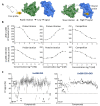Discovery of Novel Lin28 Inhibitors to Suppress Cancer Cell Stemness
- PMID: 36428779
- PMCID: PMC9688808
- DOI: 10.3390/cancers14225687
Discovery of Novel Lin28 Inhibitors to Suppress Cancer Cell Stemness
Abstract
Lin28 is a pluripotency factor that regulates cancer cell stem-like phenotypes to promote cancer development and therapy-resistant tumor progression. It acts through its cold shock domain and zinc knuckle domain (ZKD) to interact with the Let-7 pre-microRNA and block Let-7 biosynthesis. Chemical inhibition of Lin28 from interacting with Let-7 presents a therapeutic strategy for cancer therapy. Herein, we present the computer-aided development of small molecules by in silico screening 18 million compounds from the ZINC20 library, followed by the biological validation of 163 predicted compounds to confirm 15 new Lin28 inhibitors. We report three lead compounds, Ln7, Ln15, and Ln115, that target the ZKD of both Lin28A and Lin28B isoforms and block Lin28 from binding Let-7. They restore Let-7 expression and suppress tumor oncogenes such as SOX2 in cancer cells and show strong inhibitory effects on cancer cell stem-like phenotypes. However, minimal impacts of these compounds were observed on Lin28-negative cells, confirming the on-target effects of these compounds. We conclude from this study the discovery of several new Lin28 inhibitors as promising candidate compounds that warrant further drug development into potential anticancer therapies.
Keywords: Let-7; Lin28 inhibitor; RNA binding inhibitor; cancer stem cell; zinc knuckle domain.
Conflict of interest statement
The authors declare no conflict of interest.
Figures







Similar articles
-
Small-Molecule Inhibitors Disrupt let-7 Oligouridylation and Release the Selective Blockade of let-7 Processing by LIN28.Cell Rep. 2018 Jun 5;23(10):3091-3101. doi: 10.1016/j.celrep.2018.04.116. Cell Rep. 2018. PMID: 29874593 Free PMC article.
-
The Lin28 cold-shock domain remodels pre-let-7 microRNA.Nucleic Acids Res. 2012 Aug;40(15):7492-506. doi: 10.1093/nar/gks355. Epub 2012 May 8. Nucleic Acids Res. 2012. PMID: 22570413 Free PMC article.
-
LIN28 Zinc Knuckle Domain Is Required and Sufficient to Induce let-7 Oligouridylation.Cell Rep. 2017 Mar 14;18(11):2664-2675. doi: 10.1016/j.celrep.2017.02.044. Cell Rep. 2017. PMID: 28297670
-
Lin28 Regulates Cancer Cell Stemness for Tumour Progression.Cancers (Basel). 2022 Sep 24;14(19):4640. doi: 10.3390/cancers14194640. Cancers (Basel). 2022. PMID: 36230562 Free PMC article. Review.
-
The LIN28/let-7 Pathway in Cancer.Front Genet. 2017 Mar 28;8:31. doi: 10.3389/fgene.2017.00031. eCollection 2017. Front Genet. 2017. PMID: 28400788 Free PMC article. Review.
Cited by
-
Lin28 affects the proliferation and osteogenic differentiation of human dental pulp stem cells by directly inhibiting let-7b maturation.BDJ Open. 2024 Mar 5;10(1):17. doi: 10.1038/s41405-024-00194-8. BDJ Open. 2024. PMID: 38443392 Free PMC article.
-
Role of LIN28B in the Regulation of Ribosomal Biogenesis and Lipid Metabolism in Medulloblastoma Brain Cancer Cells.Proteomes. 2025 Mar 27;13(2):14. doi: 10.3390/proteomes13020014. Proteomes. 2025. PMID: 40265419 Free PMC article.
-
Splice-switching antisense oligonucleotide controlling tumor suppressor REST is a novel therapeutic medicine for neuroendocrine cancer.Mol Ther Nucleic Acids. 2024 Jul 2;35(3):102250. doi: 10.1016/j.omtn.2024.102250. eCollection 2024 Sep 10. Mol Ther Nucleic Acids. 2024. PMID: 39377066 Free PMC article.
-
Targeting Key Players of Neuroendocrine Differentiation in Prostate Cancer.Int J Mol Sci. 2023 Sep 5;24(18):13673. doi: 10.3390/ijms241813673. Int J Mol Sci. 2023. PMID: 37761978 Free PMC article. Review.
-
Lin28/let-7 axis in breast cancer.Mol Biol Rep. 2025 Mar 14;52(1):311. doi: 10.1007/s11033-025-10413-6. Mol Biol Rep. 2025. PMID: 40085362 Review.
References
-
- Chien C.-S., Wang M.-L., Chu P.-Y., Chang Y.-L., Liu W.-H., Yu C.-C., Lan Y.-T., Huang P.-I., Lee Y.-Y., Chen Y.-W., et al. Lin28B/Let-7 Regulates Expression of Oct4 and Sox2 and Reprograms Oral Squamous Cell Carcinoma Cells to a Stem-like State. Cancer Res. 2015;75:2553–2565. doi: 10.1158/0008-5472.CAN-14-2215. - DOI - PubMed
Grants and funding
LinkOut - more resources
Full Text Sources
Other Literature Sources
Research Materials

